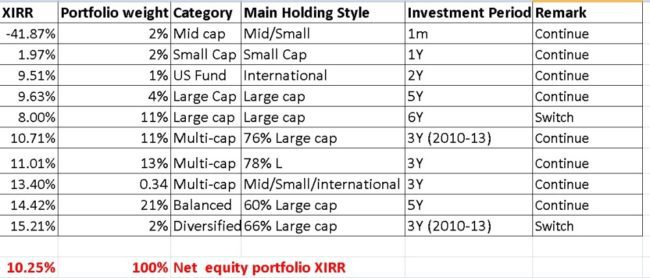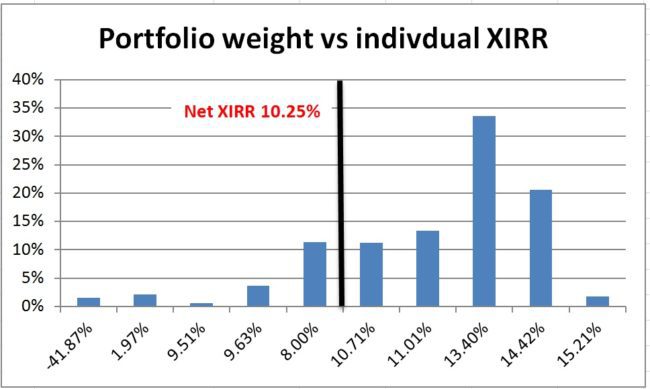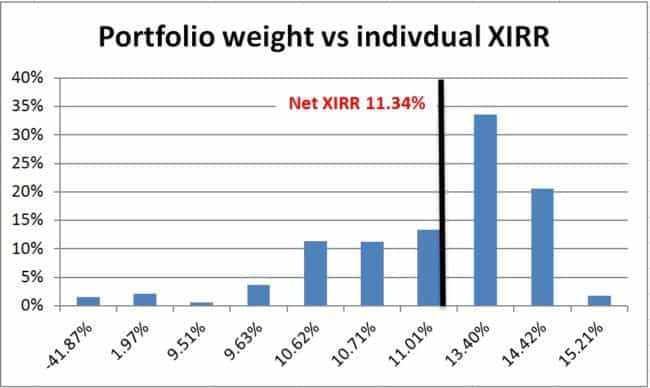Last Updated on February 4, 2016 at 8:07 am
I discuss simple ways in which a mutual fund portfolio associated with a long-term goal can be reviewed. This is a grey area in personal finance and there is no optimal way to do this. Each individual must necessarily develop their own style of review. So multiple solutions are the norm here.
This post is about reviewing an existing equity portfolio and not about creating a new one. To create a new one, you can consider reading, Minimalist Portfolio Ideas for Young Earners
Should a mutual fund portfolio be reviewed? Yes, but I think an active mutual fund should be monitored at least once a year, but given at least 5 years* to ‘perform’. Perform here refers to beating its benchmark and not faring among the best in the category.
* a personal definition. Yours could be 3 years.
Join 32,000+ readers and get free money management solutions delivered to your inbox! Subscribe to get posts via email! (Link takes you to our email sign-up form)
🔥Want to create a complete financial plan? Learn goal-based investing? Exclusive access to our DIY tools? Increase your income with your skills? Enjoy massive discounts on our robo-advisory tool & courses! 🔥
If the fund has not beat its benchmark, then the reasons must be investigated before thinking about making a change:
- If the fund has not beat its benchmark during a period (say, 5Y) in which the benchmark went up, chuck it!
- If the fund is moving south when the benchmark is moving north, chuck it (can be even after 1-2Y)
- If the fund has not beat the benchmark, but has stayed close to it, find out how funds of similar age have performed.
- If they have fared better, then you can consider a shift (the situation may reverse after you exit!)
- If they too have not done well, you either ‘stay put’ or consider a newer fund with a short, but impressive history. Again, could turn out to be a mistake!
Please recognize that fund selection and fund switches are arbitrary beyond a point! You take a chance and hope for the best.
How do I switch?
This is a common question among investors. ‘What do I do with current holdings? Do I leave them as is, and continue fresh investments in the new fund? Or do I switch out completely?
In the interest of maintaining a clutter-free portfolio, I would recommend a complete but gradual switch out, keeping exit load and taxation in mind wrt existing units. However, this is easier said, than done.
Types of mutual fund reviews
We review our holdings for many different reasons:
- we may just realize that we are holding 20 funds instead of just 1/2 which would do.
- routine annual review
- review to decide on how to reduce equity exposure as goal approaches.
- rebalancing, tactical moves etc.
Example of a mutual fund review
What is presented below are my thoughts on the subject and is a combination of ‘how I do it‘ and ‘how I would do it‘. Let us start with assumptions.
- The goal is several years away (short-term goal management is a different ball game. It the folio has debt, then there is not much to do. If it has a lot of equity, one should pray a lot!)
- We have a clear expected return from our total equity folio (this review is for the equity portion of the folio. We will assume the debt part has minimal volatility and does not need frequent reviews)
- Action here refers to fund changes only. Other actions like rebalancing or tactical asset allocation depend on equity:debt allocation or economic indicators and are not considered.
- The entire portfolio should be at least be 5Y old. There is no hurry for new investors with folios younger than 5Y to take any action and I strongly suggest they monitor their investment patterns and not the folio performance.
- We will monitor the folio, say each month but will only take action once a year after we have been investing for at least 5Y.
- There are several types of folios (minimalist, mildly cluttered, severely cluttered). So course of action will differ. We will consider a cluttered folio. It is easy to extrapolate the gist of the argument to any folio. If you have any questions, feel free to ask.
Pretty much every action in personal finance needs a benchmark. The more personal they are, the easier it is to decide.
So the first benchmark is to have a return expectation. This expectation should be reasonable and must keep in mind associated volatility. The folio may have a net return much lower than expected for several months and at times years.
The second benchmark is the net return from the portfolio at any given time. This is calculated using what is known as the XIRR (read more about this here)
The XIRR is, by definition a personal benchmark. ‘How has the fund performed?‘ is now quantified by, ‘What is my XIRR from the fund?‘
It is a personal benchmark because no two people’s XIRR will be the same, unless they invest on exactly the same dates.
This is why star ratings are irrelevant once I invest in a fund (they are irrelevant even before that because, imo they do not reward/penalize long-term consistency/inconsistency. An investor is better off doing their own analysis).
Once I invest in a fund, all that matter to me is its impact on my folio and not how it compares with its peers (star rating).
So, once I have an expectation from equity, the next task is to find out the net XIRR (this is the rate at which all your investments have compounded on an average. This is the equivalent of the CAGR when multiple investments are made).
You can do this by entering ALL your transactions in a portal like Value Research or my mutual fund tracker or Mprofit. Not sure if Perfios gives this.
You should now have a table of the current value of all your funds, their individual XIRRs and the net XIRR.
Something like this (click to enlarge). This is a fabrication.
Example 1

 The portfolio weight (fund value/portfolio value) is plotted against the XIRR (x-axis). The black line represents the next XIRR.
The portfolio weight (fund value/portfolio value) is plotted against the XIRR (x-axis). The black line represents the next XIRR.

The black line can be thought of as the fulcrum of a seesaw. In diversified portfolio, some funds will always have a return lower than the net XIRR, but the fulcrum is positioned in such a way that the seesaw(the portfolio) is held steady instead of tipping either way.
The above portfolio is heavy on large caps. So the obvious choice is to reduce large cap exposure. There is a large cap fund with 11% weight and 8% return. That can be redeemed and invested into the large cap fund with 4% exposure.
Any non-unique fund that is at least a few years old (in your folio), and has an XIRR that is well below the net XIRR can be considered for removal.
Further trimming is possible, but there is no need to make unnecessary changes. Most portfolios would be far from perfect. They can be gradually modified.
Example 2. The above example was modified for simplicity. These are the actual numbers. What do make out of this?
The choice here is not so straightforward. If you want to trim down the folio, deeper study is required along with some ruthless changes. I would personally leave this be for a while.
One can also consider using the Moneycontrol edition: Equity Mutual Fund Portfolio Comparison Tool to check for significant overlap. If this is pretty high, say above 40% and the top holdings identical, then one of the funds can be removed.
Instead of switching out, one could also leave the existing units alone invest in other funds. Soon the portfolio weights of the laggards will decrease and not make much of an impact. The fulcrum will shift!
The idea of this post is to point out the importance of making a table as the one shown above. This offers a better perspective of the movers and shakers of the folio. This makes it easy to decide the next course of action.
I like a large XIRR as much as any other person. So a second approach is to try (and hope) to keep the net XIRR well above the return expectation and make gradual changes to increase the distance between the two benchmarks (expectation and net XIRR) as much as possible.
That is, one could try and move the black line to the right by increasing weights of the funds with have returned the highest. This has to be done without affecting diversification.
One cannot accomplish this with knee-jerk changes. The idea is to do it with a method and to do it gradually. Not having an SIP helps in this regard. Monthly investing can still continue.
It is best to not get emotionally attached to a fund and to be ruthless, but objective. This is something I am not very good at, but have changed in the past couple of years. Ruthless does not mean immediate. Change can take a few months to happen. After all, exit loads and taxation are also important.
Changes can hurt. The fund we exited can go on to do quite well and the new fund plumb new depths.
What is proposed above is only one of a zillion possibilities. The idea of this post to highlight the importance of personal benchmarks. There are many solutions to this problem. Personally, I prefer benchmarking XIRR of each fund with the folios net XIRR. Feel free to critique and propose alternative strategies.
If the portfolio was minimalist to begin with, nothing need be done as long as the net XIRR is close to above our expectation from equity for a particular goal. This is the sweet spot, Ashal Jauhari finds himself in 🙂
🔥Enjoy massive discounts on our courses, robo-advisory tool and exclusive investor circle! 🔥& join our community of 7000+ users!
Use our Robo-advisory Tool for a start-to-finish financial plan! ⇐ More than 2,500 investors and advisors use this!
Track your mutual funds and stock investments with this Google Sheet!
We also publish monthly equity mutual funds, debt and hybrid mutual funds, index funds and ETF screeners and momentum, low-volatility stock screeners.





- Do you have a comment about the above article? Reach out to us on Twitter: @freefincal or @pattufreefincal
- Have a question? Subscribe to our newsletter using the form below.
- Hit 'reply' to any email from us! We do not offer personalized investment advice. We can write a detailed article without mentioning your name if you have a generic question.
Join 32,000+ readers and get free money management solutions delivered to your inbox! Subscribe to get posts via email! (Link takes you to our email sign-up form)
About The Author
 Dr M. Pattabiraman(PhD) is the founder, managing editor and primary author of freefincal. He is an associate professor at the Indian Institute of Technology, Madras. He has over ten years of experience publishing news analysis, research and financial product development. Connect with him via Twitter(X), Linkedin, or YouTube. Pattabiraman has co-authored three print books: (1) You can be rich too with goal-based investing (CNBC TV18) for DIY investors. (2) Gamechanger for young earners. (3) Chinchu Gets a Superpower! for kids. He has also written seven other free e-books on various money management topics. He is a patron and co-founder of “Fee-only India,” an organisation promoting unbiased, commission-free investment advice.
Dr M. Pattabiraman(PhD) is the founder, managing editor and primary author of freefincal. He is an associate professor at the Indian Institute of Technology, Madras. He has over ten years of experience publishing news analysis, research and financial product development. Connect with him via Twitter(X), Linkedin, or YouTube. Pattabiraman has co-authored three print books: (1) You can be rich too with goal-based investing (CNBC TV18) for DIY investors. (2) Gamechanger for young earners. (3) Chinchu Gets a Superpower! for kids. He has also written seven other free e-books on various money management topics. He is a patron and co-founder of “Fee-only India,” an organisation promoting unbiased, commission-free investment advice.Our flagship course! Learn to manage your portfolio like a pro to achieve your goals regardless of market conditions! ⇐ More than 3,000 investors and advisors are part of our exclusive community! Get clarity on how to plan for your goals and achieve the necessary corpus no matter the market condition is!! Watch the first lecture for free! One-time payment! No recurring fees! Life-long access to videos! Reduce fear, uncertainty and doubt while investing! Learn how to plan for your goals before and after retirement with confidence.
Our new course! Increase your income by getting people to pay for your skills! ⇐ More than 700 salaried employees, entrepreneurs and financial advisors are part of our exclusive community! Learn how to get people to pay for your skills! Whether you are a professional or small business owner who wants more clients via online visibility or a salaried person wanting a side income or passive income, we will show you how to achieve this by showcasing your skills and building a community that trusts and pays you! (watch 1st lecture for free). One-time payment! No recurring fees! Life-long access to videos!
Our new book for kids: “Chinchu Gets a Superpower!” is now available!


Must-read book even for adults! This is something that every parent should teach their kids right from their young age. The importance of money management and decision making based on their wants and needs. Very nicely written in simple terms. - Arun.Buy the book: Chinchu gets a superpower for your child!
How to profit from content writing: Our new ebook is for those interested in getting side income via content writing. It is available at a 50% discount for Rs. 500 only!
Do you want to check if the market is overvalued or undervalued? Use our market valuation tool (it will work with any index!), or get the Tactical Buy/Sell timing tool!
We publish monthly mutual fund screeners and momentum, low-volatility stock screeners.
About freefincal & its content policy. Freefincal is a News Media Organization dedicated to providing original analysis, reports, reviews and insights on mutual funds, stocks, investing, retirement and personal finance developments. We do so without conflict of interest and bias. Follow us on Google News. Freefincal serves more than three million readers a year (5 million page views) with articles based only on factual information and detailed analysis by its authors. All statements made will be verified with credible and knowledgeable sources before publication. Freefincal does not publish paid articles, promotions, PR, satire or opinions without data. All opinions will be inferences backed by verifiable, reproducible evidence/data. Contact information: To get in touch, use this contact form. (Sponsored posts or paid collaborations will not be entertained.)
Connect with us on social media
- Twitter @freefincal
- Subscribe to our YouTube Videos
- Posts feed via Feedburner.
Our publications
You Can Be Rich Too with Goal-Based Investing
 Published by CNBC TV18, this book is meant to help you ask the right questions and seek the correct answers, and since it comes with nine online calculators, you can also create custom solutions for your lifestyle! Get it now.
Published by CNBC TV18, this book is meant to help you ask the right questions and seek the correct answers, and since it comes with nine online calculators, you can also create custom solutions for your lifestyle! Get it now.Gamechanger: Forget Startups, Join Corporate & Still Live the Rich Life You Want
 This book is meant for young earners to get their basics right from day one! It will also help you travel to exotic places at a low cost! Get it or gift it to a young earner.
This book is meant for young earners to get their basics right from day one! It will also help you travel to exotic places at a low cost! Get it or gift it to a young earner.Your Ultimate Guide to Travel
 This is an in-depth dive into vacation planning, finding cheap flights, budget accommodation, what to do when travelling, and how travelling slowly is better financially and psychologically, with links to the web pages and hand-holding at every step. Get the pdf for Rs 300 (instant download)
This is an in-depth dive into vacation planning, finding cheap flights, budget accommodation, what to do when travelling, and how travelling slowly is better financially and psychologically, with links to the web pages and hand-holding at every step. Get the pdf for Rs 300 (instant download)
